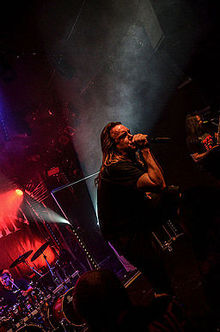Technical death metal
 From Wikipedia - Reading time: 7 min
From Wikipedia - Reading time: 7 min
| Technical death metal | |
|---|---|
| Other names |
|
| Stylistic origins | |
| Cultural origins | Late 1980s, United States, Canada and Europe |
| Other topics | |
Technical death metal (also known as tech death) is a musical subgenre of death metal with particular focus on instrumental skill and complex songwriting. Technical and progressive experimentation in death metal began in the late 1980s and early 1990s, largely driven by four bands that, according to Allmusic, are "technical death metal's Big Four" – Death, Pestilence, Atheist, and Cynic. All but Pestilence are part of the Florida death metal scene,[2][3] to which Nocturnus, another influential band, also belongs.[4]
Characteristics
[edit]
Distinct features of the subgenre include dynamic song structures, complex and atypical rhythmic structures, abundant use of diminished chords and arpeggios, frequent employment of odd time chord progressions, and consistent use of techniques such as string skipping in the guitar work. Bass lines are usually complex, and drumming is complex including techniques such as blast beats, odd time signatures and double kicks. The technical death metal genre has also been influenced by mostly jazz fusion,[1] as well as thrash metal and progressive/technical-inspired heavy metal bands like Death,[5][6] Megadeth,[7] Slayer,[5][8] Voivod,[9] Kreator,[6] Dark Angel,[7] Coroner,[6] Sadus,[10] and Watchtower, the latter of whose second album Control and Resistance (1989) is often considered to be one of the sources of inspiration for the genre.[11][12]
History
[edit]
The 1990 album The Key by Nocturnus has been cited as the first progressive death metal album.[13] One of the key works that cemented the subgenre was Atheist's debut album Piece of Time, also released in 1990, which took death metal into a more intricate level while incorporating influences ranging from jazz fusion to progressive metal. In 1991, New York death metal group Suffocation released their debut album Effigy of the Forgotten, which focused on pairing speed and brutality with a "sophisticated" sense of songwriting. Atheist's second album Unquestionable Presence, Pestilence's third album Testimony of the Ancients, and Death's fourth album Human were all released the same year, forging a path for more intricate and refined releases within the death metal genre.[3]
See also
[edit]References
[edit]- ^ a b "100 Greatest Technical Death Metal Bands And Technical Thrash Metal Bands". May 8, 2015. Retrieved March 19, 2018.
- ^ Freeman, Phil. "Resurrection Macabre review". AllMusic. Retrieved August 15, 2009.
- ^ a b Freeman, Phil. "The Man-Machine Will Rock You: The Existential Paradox of Technical Death Metal". The High Hat. Archived from the original on June 21, 2012. Retrieved August 15, 2009.
- ^ Swiniartzki, Marco. "Why Florida?: Regional conditions and further development of the "Florida death metal"". University of California press.
- ^ a b "Pestilence: Patrick Mameli makes no compromise". radiometal.com. Retrieved March 22, 2021.
- ^ a b c "GORY BLISTER – Battle Helm". battlehelm.com. Retrieved March 22, 2021.
- ^ a b "Revocation interview". Lords of Metal. November 2009. Archived from the original on March 11, 2016. Retrieved March 22, 2021.
- ^ "The Metal Crypt - Jeff Hanneman Tribute Interview". metalcrypt.com. Retrieved March 22, 2021.
- ^ "Iconic metal band Voivod get postapocalyptic on The Wake". Chicago Reader. March 14, 2019. Retrieved March 22, 2021.
- ^ "An Abridged Guide to Technical Thrash Metal (1984-Present): 50 Key Full-Lengths". grizzlybutts.com. January 26, 2018. Retrieved March 22, 2021.
- ^ "Watchtower - Concepts Of Math : Book One EP - Album Review 2016". powerofprog.com. October 14, 2016. Retrieved March 22, 2021.
- ^ ""Control was just the natural progression for us"". metalindex.hu. November 15, 2019. Retrieved March 22, 2021.
- ^ BadWolf (July 13, 2012). "Effigies of the Forgotten". NoCleanSinging. Retrieved June 26, 2021.
 KSF
KSF